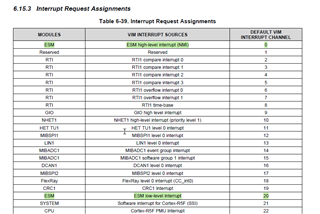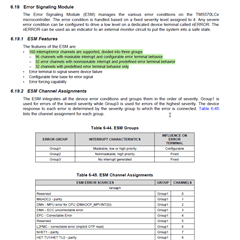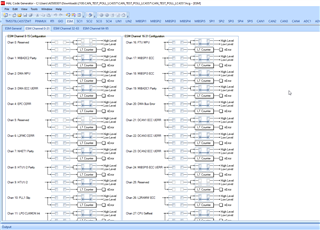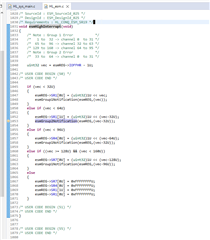Hi,
I have combined all of the SDL examples and now I only want to use a single callback and configuration functions. So, I am trying to fully understand the ESM configuration.
This link helps with ESM configuration, but I seem to need more help. https://e2e.ti.com/support/processors-group/processors/f/processors-forum/1265594/faq-am64x-am62x-am62ax-configuring-the-esm-module-from-sdl-and-setting-the-esm-bit-fields-to-enable-the-esm-error-events
First, I am unsure what this is used for. It is not discussed in the link. .esmErrorConfig = {1u, 8u}, /*Error event to be used for self test */
Second, from the link, I understand that there are 177 ESM Interrupts in the MAIN domain and 64 in the MCU Domain. I am a bit confused because the examples seem to enable more than just the 177 interrupts. This is what I think the configuration would look like if I were to enable the 177 interrupts in the MAIN domain and 64 interrupts in the MCU domain.
/* Main Domain */
.enableBitmap = {0xffffffffu, 0xffffffffu, 0xffffffffu, 0xffffffffu, //128
0xffffffffu, 0x0001ffffu, 0x00000000u, 0x00000000u, //256
0x00000000u, 0x00000000u, 0x00000000u, 0x00000000u, //384
0x00000000u, 0x00000000u, 0x00000000u, 0x00000000u, //512
0x00000000u, 0x00000000u, 0x00000000u, 0x00000000u, //640
0x00000000u, 0x00000000u, 0x00000000u, 0x00000000u, //768
0x00000000u, 0x00000000u, 0x00000000u, 0x00000000u, //896
0x00000000u, 0x00000000u, 0x00000000u, 0x00000000u, //1024
},
/* MCU Domain */
.enableBitmap = { 0xffffffffu, 0xffffffffu, 0x00000000u, 0x00000000u, //128
0x00000000u, 0x00000000u, 0x00000000u, 0x00000000u, //256
0x00000000u, 0x00000000u, 0x00000000u, 0x00000000u, //384
0x00000000u, 0x00000000u, 0x00000000u, 0x00000000u, //512
0x00000000u, 0x00000000u, 0x00000000u, 0x00000000u, //640
0x00000000u, 0x00000000u, 0x00000000u, 0x00000000u, //768
0x00000000u, 0x00000000u, 0x00000000u, 0x00000000u, //896
0x00000000u, 0x00000000u, 0x00000000u, 0x00000000u, //1024
},
Third, I received a high priority interrupt from grpChannel 5, index 2, intSrc 65. Now, I am trying to figure out where that interrupt came from. I believe it maps to RTI11_INTR_WWD_0 if I am not mistaken.
Lastly, I am not sure what intSrc means. (I am referring to the callback )
int32_t ESM_callback(SDL_ESM_Inst esmInstType,
SDL_ESM_IntType esmIntType,
uint32_t grpChannel,
uint32_t index,
uint32_t intSrc,
void *arg)
Thank you,







